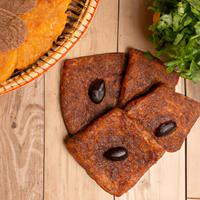
1 serving (150 grams) contains 300 calories, 25.0 grams of protein, 20.0 grams of fat, and 0.0 grams of carbohydrates.

Log this food in SnapCalorie

Nutrition Information
Calories |
476.2 | ||
|---|---|---|---|
% Daily Value* |
|||
| Total Fat | 31.7 g | 40% | |
| Saturated Fat | 12.7 g | 63% | |
| Polyunsaturated Fat | 0 g | ||
| Cholesterol | 127.0 mg | 42% | |
| Sodium | 119.0 mg | 5% | |
| Total Carbohydrates | 0 g | 0% | |
| Dietary Fiber | 0 g | 0% | |
| Sugars | 0 g | ||
| protein | 39.7 g | 79% | |
| Vitamin D | 0 mcg | 0% | |
| Calcium | 15.9 mg | 1% | |
| Iron | 3.2 mg | 17% | |
| Potassium | 555.6 mg | 11% | |
* Percent Daily Values are based on a 2,000 calorie diet. Your daily values may be higher or lower depending on your calorie needs.
Food Attributes
Source of Calories
About Nakkekoteletter
Nakkekoteletter, or pork neck chops, are a popular dish in Scandinavian cuisine, particularly in Denmark and Norway. These cuts of meat come from the neck or shoulder area of the pig, offering a rich, marbled texture that contributes to their tenderness and flavor. Often grilled, pan-fried, or oven-baked, nakkekoteletter are typically seasoned with herbs and spices and can be paired with vegetables, potatoes, or sauces for a hearty meal. Nutritionally, they are a good source of protein and essential vitamins like B12, which supports energy production and nervous system health. However, their fat content, particularly saturated fat, can be significant, so portion control is advised for those monitoring cholesterol levels or seeking a lower-fat diet. When prepared with lean trimming methods and complemented by healthy sides, nakkekoteletter can be part of a balanced meal enjoyed in Scandinavian culinary tradition.



